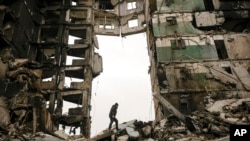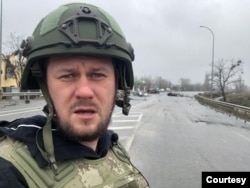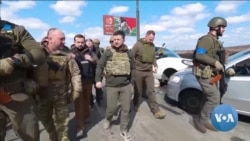"There were dead bodies everywhere on the street, destroyed cars with dead people inside, burned cars, some with bullet holes,” said Denis Kazansky.
The Ukrainian journalist is still reeling from what he found last week in Bucha.
The affluent suburb of Kyiv was under Russian occupation for more than a month. When Russian troops withdrew on March 31, Kazansky and other journalists embedded with the Ukrainian military were among the first to arrive.
“I tried to film everything I saw that day, because these were war crimes and the world needed to see them,” said Kazansky, an investigative reporter with TV channel Ukraine 24.
Originally from Donetsk — an eastern region partially controlled by Russian-backed separatists — Kazansky is more used to reporting on criminal activity, including illegal coal mining and corruption in his home region.
Horrific stories
In Bucha, residents told him how Russian soldiers killed and tortured civilians. Inside several looted houses, he saw dead people and dogs.
The 38-year-old journalist documented everything.
“These were bodies of civilians, for sure,” he told VOA in a recent phone call. “But we need to investigate. We need to find the names and identities of these people to prove that what Russian soldiers did in Bucha were undeniably war crimes.”
At least 400 bodies were found in Bucha, according to the town’s mayor, Anatoliy Fedoruk.
U.S. President Joe Biden has said Russian President Vladimir Putin should be tried for war crimes.
Efforts under way
The International Criminal Court in The Hague has already opened an investigation into alleged war crimes committed on Ukrainian territory. The European Union has said it will provide funding and support to the ICC.
And rights groups such as Human Rights Watch and Amnesty International are on the ground, working to collect evidence of alleged crimes.
Journalist organizations, like the investigative news website Bihus.info, are joining those efforts.
“We try to gather everything related to Russian military actions in Ukraine that could be used as a piece of evidence at some point,” said Maks Opanasenko, chief editor with Bihus.info.
With about two dozen reporters and researchers and a network of Ukrainian journalists from other news organizations, Bihus.info has a two-pronged approach: collecting witness testimony and identifying Russian troops in Ukraine.
“Our field reporters go to the scene of any particular attack and begin carrying out detailed interviews,” Opanasenko said.
The goal is to record everything while people’s memories are still fresh, Opanasenko said, adding that the team does follow-up interviews “to make sure we have as accurate accounts as possible.”
When it comes to identifying Russian troops in Ukraine, the team uses open-source information.
“Social media has a lot more information than we think,” Opanasenko said. “We collect information via social media platforms about Russian soldiers and compare them against data that the Ukrainian government publishes about Russian soldiers who are already in Ukraine.”
It’s a challenging task, given that Western officials estimate more than 150,000 Russian troops are involved in the war in Ukraine. But Bihus.info researchers have already created a growing database.
“Our objective is to one day rely on information from this database to identify potential Russian perpetrators against civilians and use them in war crime trials,” Opanasenko said.
Syrian experience
Journalists who have lived through Russian-involved conflict have ready advice for their Ukrainian colleagues.
Since 2015, Russian forces have carried out airstrikes on rebel-held areas in Syria on behalf of President Bashar al-Assad’s regime. Some targeted medical facilities and civilian areas.
Local journalists were the first to document those attacks, experts said.
“Journalists had a major role in documenting the remnants of those Russian airstrikes, which eventually prompted the U.N. to release an official report directly indicating that Russia was behind targeting those hospitals,” said Ali Al Ibrahim.
The investigative journalist is a founding member of the Syrian Investigative Reporting for Accountability Journalism (SIRAJ).
Founded in 2016, SIRAJ has been gathering evidence about attacks on civilians by Russia and other parties involved in Syria’s decadelong conflict.
With similar tactics in Ukraine, the Syrian investigative reporting unit said Ukrainian journalists need to be precise in collecting evidence.
“They need to collect and document anything they find, from remnants of missiles and cluster munitions to testimonies of local residents and open-source information,” Al Ibrahim told VOA.
“Cross-examination of [this] information is key to determine whether Russia has deliberately targeted civilian-populated areas in Ukraine,” he added.
Al Ibrahim acknowledged that carrying out such diligent work while the war is still unfolding is difficult, but he said its impact would be crucial.
“Just like how Syria has been, Ukraine is a full crime scene now,” he said. “And Ukrainian journalists may not see direct results with their documentation work today.”
But, he said, “Drawing on our experience in Syria, it is important to keep persistent until tangible results emerge.”
Long process
It took nearly six years of documenting Russian military actions in Syria for the U.N. to say Russia was involved in war crimes, Al Ibrahim said.
"So I’m confident that one day, thanks to the work of hardworking journalists in Syria and Ukraine, Russian officials responsible for war crimes will be brought to justice,” the Syrian journalist said.
Journalist Kazansky recognizes too that his documentation of possible war crimes in Bucha is just the beginning of a lengthy mission.
“I’ve been doing this just for a few days now, but I will go back to Bucha and try to collect more evidence and talk to more people,” he said. “More information and investigation into what happened there is needed.”
Kazansky said that he was still processing the horrors he witnessed in Bucha, but that he believed Russia had perpetrated many other war crimes across the country.
“It is a big country and there is still a lot of work that needs to be done.”













